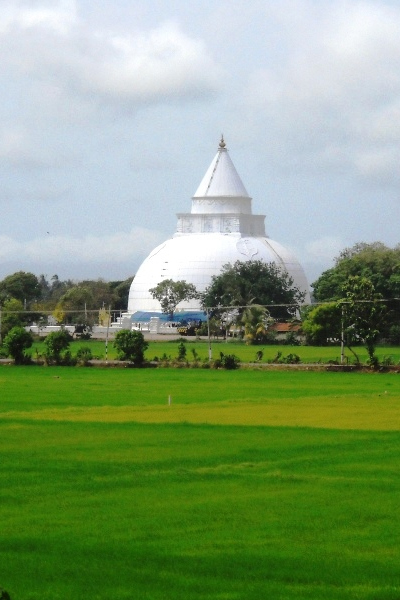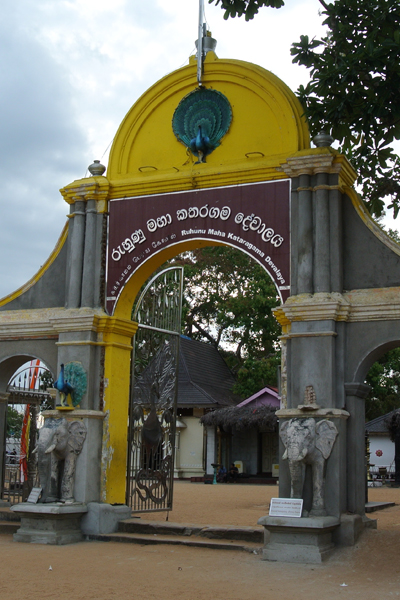

Bundala National Park is situated 245 kilometers (152 miles) southeast of Colombo. Bundala National Park was declared a wildlife sanctuary on 5 December 1969 and was upgraded to a National Park on 4 January 1993. In 1991, Bundala became the first wetland in Sri Lanka to be designated as a Ramsar Wetland and further in 2005, Bundala was declared a Man and Biosphere Reserve by UNESCO, the fourth biosphere reserve in Sri Lanka.
Bundala National Park is an outstanding Important Bird Area (IBA) in the South Indian and Sri Lankan wetlands. 324 species of vertebrates have been recorded including 32 species of fish, 15 species of amphibians, 48 species of reptiles, 197 species of birds and 32 species of mammals. 52 species of butterflies are among the invertebrates. Out of 197 species of birds, 58 are migratory species. National Bird Ringing Programme (NBRP) was launched in Bundala by in collaboration of Department of Wildlife Conservation and Field Ornithology Group of Sri Lanka in 2005.
The national park is surrounded by five lagoons namely; Bundala lagoon, Embilikala lagoon, Malala lagoon, Koholankala lagoon and the Mahalewaya lagoon. A total of 383 plant species belonging to 90 families have been recorded from the park. The Phytoplankton in all the lagoons is dominated by blue-green algae including species such as Macrocystis, Nostoc, Oscillatoria. Hydrilla is in abundance in lagoons such as Embilikala and Malala. Water hyacinth, water lilies and Typhaangustifolia reed beds are found in the marshes and streams. The vegetation mainly consists of Acacia scrubs including Dichrostachyscinerea, Randiadumetorum, Ziziphus sp., Gymnosporiaemarginata, Carissa spinarum, Cappariszeylanica and Cassia spp. The trees of the forest are Bauhinia racemosa, Salvadorapersica, Drypetessepiaria, Manilkarahexandra (Palu in Sinhalese), and less common Chloroxylonswietenia,
The unique and complex wetland system attracts the wintering birds that fly to escape the freezing climate and to rest their weather beaten bodies. Hence Bundala is the ideal grounds to observe the colourful migratory water birds and local air dominators, out of which greater flamingo takes the hotspot.
The greater flamingo (Phoenicopterus roseus) which visits in large flocks of over 1,000 individuals, from Rann of Kutch of India is being the highlight. Waterfowls such as lesser whistling duck (Dendrocygna javanica) and garganey (Anas querquedula), cormorants such as little cormorant (Phalacrocorax niger) and Indian cormorant (P. fuscicollis), large water birds such as grey heron (Ardea cinerea), black-headed ibis (Threskiornis melanocephalus), Eurasian spoonbill (Platalea leucorodia), Asian openbill (Anastomus oscitans), painted stork (Mycteria leucocephala), medium sized waders such as Tringa and small waders such as Charadrius are the other avifaunal species which are present in large flocks. Black-necked stork (Ephippiorhynchus asiaticus), lesser adjutant (Leptoptilos javanicus) and Eurasian coot (Fulica atra) are rare birds inhabit in the national park.
A few Asian elephants still inhabit the forests of Bundala. Other mammals seen in the park are toque macaque, common langur, jackal, leopard, fishing cat, rusty-spotted cat, mongoose, wild boar, mouse deer, Indian muntjac, spotted deer, sambar, black-naped hare, Indian pangolin and porcupine.
Bundala harbors various forms of fish including salt water dispersants, marine forms, brackish water forms and freshwater forms. Bundala's herpetofauna includes two endemic species, a toad and a snake, Bufo atukoralei and Xenochrophis asperrimus. Among reptiles are mugger crocodile Crocodylus palustris, estuarine crocodile Crocodylus porosus, common monitor Varanus bengalensis, star tortoise Geochelone elegans, python Python molurus, rat snake Pytas mucosus, endemic flying snake Chrysopelea taprobana, cat snakes Boiga spp. and whip snakes Dryophis spp. The adjacent seashore of Bundala is a breeding ground for all five species of globally endangered sea turtles that migrate to Sri Lanka. Bundala is also one of 3 wetlands in the island so if you're lucky enough, you will get a chance to behold a salt water crocodile.

